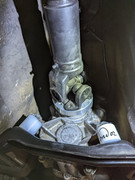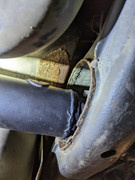Hey guys,
First post here, loooong time lurker however. Ill introduce myself/car in another post later. Purchased my E30 325i coupe after about 10 years of searching. Doing a turbo M20 street car build with an occasional track day. Focusing on suspension/brake/driveline for now, but I have a spare M20 on the stand waiting for a build. Shooting for 400whp.
After a ton of searching i'm looking for some advice. Basically, what I've got going on here is my OEM D/S was shot, I took it to a respected and highly recommended (by my local E30 community) driveline shop to have the shaft rebuilt. Given the goals of my project I was recommended I move to a 1 piece driveshaft, after plenty of research we did some math and measuring, and I now have a 1 piece 3" tube steel shaft + aluminum guibo + some big boy (replaceable ;) ) u-joints and it is designed to hold well over the power figure I will ever put through it at critical speeds higher than it should ever see. Anyway... I was putting it in tonight for a test fit, as expected with any custom bits I've got some tweaks to make.
The shaft bolts up perfectly on the transmission end, on the diff end however the larger diameter shaft is contacting the "saddle" of the fuel tank ever so slightly. Right at the point before it goes through the subframe hole.
It is worth noting that I have the jack stands on the subframe, so the bushings are compressed as much as they ever will be, once the weight is off the subframe id expect another ~1/4" of clearance. The bushings are still OEM rubber so i'm potentially losing some clearance there. However I still think id like a little more margin of safety there. I have Condor 12mm solid riser bushings/diff spacers waiting to be installed (this winters project, although I was hoping to move the car). I have seen several LS/M60 swap guys run 3" shafts with this same issue.
The long and the short is, the way I see it, I have a few potential solutions. Which direction should I head first?
-Pull the subframe, replace with the condor bushings, hope it fixes it. The riser bushings will compound my issue, but the included diff spacers will likely put it right back where it is now... unless the OEM rubbers are THAT sloppy. I have RTAB/Diff bushings to go in as well. Seems like the obvious choice, but again, I would really like to move the car first.
-Diff spacers. Something i'm unfamiliar with, but I see some of the V8 guys do this... will everything still bolt up with JUST spacers?
-Clearance the fuel tank saddle. Something id like to avoid if possible. However I came across THIS article of exactly this. I would likely attempt this with the tank in the car still.
-Abandon the 1 piece, I was an idiot for trying something and it backfired lol. Ill need a new OEM D/S + output flange as mine has had some machining done to eliminate the centering bushing.
Any input is appreciated, I will grab some photos tomorrow. Thanks guys, happy to finally join the forum!
First post here, loooong time lurker however. Ill introduce myself/car in another post later. Purchased my E30 325i coupe after about 10 years of searching. Doing a turbo M20 street car build with an occasional track day. Focusing on suspension/brake/driveline for now, but I have a spare M20 on the stand waiting for a build. Shooting for 400whp.
After a ton of searching i'm looking for some advice. Basically, what I've got going on here is my OEM D/S was shot, I took it to a respected and highly recommended (by my local E30 community) driveline shop to have the shaft rebuilt. Given the goals of my project I was recommended I move to a 1 piece driveshaft, after plenty of research we did some math and measuring, and I now have a 1 piece 3" tube steel shaft + aluminum guibo + some big boy (replaceable ;) ) u-joints and it is designed to hold well over the power figure I will ever put through it at critical speeds higher than it should ever see. Anyway... I was putting it in tonight for a test fit, as expected with any custom bits I've got some tweaks to make.
The shaft bolts up perfectly on the transmission end, on the diff end however the larger diameter shaft is contacting the "saddle" of the fuel tank ever so slightly. Right at the point before it goes through the subframe hole.
It is worth noting that I have the jack stands on the subframe, so the bushings are compressed as much as they ever will be, once the weight is off the subframe id expect another ~1/4" of clearance. The bushings are still OEM rubber so i'm potentially losing some clearance there. However I still think id like a little more margin of safety there. I have Condor 12mm solid riser bushings/diff spacers waiting to be installed (this winters project, although I was hoping to move the car). I have seen several LS/M60 swap guys run 3" shafts with this same issue.
The long and the short is, the way I see it, I have a few potential solutions. Which direction should I head first?
-Pull the subframe, replace with the condor bushings, hope it fixes it. The riser bushings will compound my issue, but the included diff spacers will likely put it right back where it is now... unless the OEM rubbers are THAT sloppy. I have RTAB/Diff bushings to go in as well. Seems like the obvious choice, but again, I would really like to move the car first.
-Diff spacers. Something i'm unfamiliar with, but I see some of the V8 guys do this... will everything still bolt up with JUST spacers?
-Clearance the fuel tank saddle. Something id like to avoid if possible. However I came across THIS article of exactly this. I would likely attempt this with the tank in the car still.
-Abandon the 1 piece, I was an idiot for trying something and it backfired lol. Ill need a new OEM D/S + output flange as mine has had some machining done to eliminate the centering bushing.
Any input is appreciated, I will grab some photos tomorrow. Thanks guys, happy to finally join the forum!





Comment